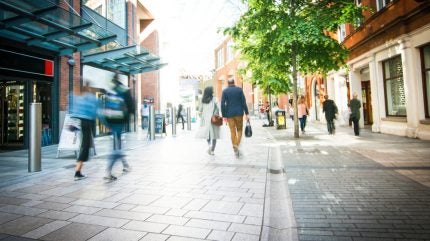
UK retail footfall fell again in August, marking the fourth consecutive month of decline, though high streets showed signs of life. Industry leaders warn that without targeted government reforms, this fragile recovery could fade.
High streets show growth while retail parks falter
Figures from BRC-Sensormatic revealed that overall UK footfall slipped 0.4 percent year-on-year in August, unchanged from July. High streets performed better, recording a 1.1 percent increase after a sharp drop the previous month.

Discover B2B Marketing That Performs
Combine business intelligence and editorial excellence to reach engaged professionals across 36 leading media platforms.
Retail parks fell back into decline with a 1.1 percent decrease, while shopping centres remained flat.
According to Helen Dickinson, chief executive of the British Retail Consortium, the warm weather helped drive shoppers into towns and cities, with Birmingham, Sheffield and Manchester among the strongest performers.
Yet she cautioned that the same conditions “did not provide a boost to retail parks and shopping centres,” which remain under pressure despite city centres seeing renewed interest.
Regional variation points to fragile recovery
The improvement on the high street was not enough to offset falls elsewhere. England recorded a 0.2 percent decline, Scotland 0.4 percent, Northern Ireland 1.7 percent and Wales the steepest fall at 2.6 percent.

US Tariffs are shifting - will you react or anticipate?
Don’t let policy changes catch you off guard. Stay proactive with real-time data and expert analysis.
By GlobalDataBirmingham’s 6.2 percent rise and Sheffield’s 5.7 percent increase highlighted how some urban centres bucked the national picture.
Andy Sumpter, retail consultant at Sensormatic, noted that even though August marked the end of the hottest summer on record, “footfall stayed cool—flatlining at -0.4 percent.”
He argued that shoppers are still present and “shopping around,” but that growth will only come if retailers take bold steps in investment and innovation, rather than relying on temporary boosts from weather or events.
Retailers press for government support
Rising operating costs remain a central concern for the sector. Dickinson pointed out that the last Budget introduced £7 billion in new costs, which has “limited retailers’ ability to invest in local communities.”
She argued that forthcoming business rates reforms represent a “golden opportunity” for the government to ease financial pressures, ensuring no shop faces higher charges and enabling businesses to reinvest in jobs and local areas.
Sumpter added that service quality, which often determines customer loyalty, depends on labour—and with wages climbing, delivering that service is more expensive than ever.
He warned that “resilience alone won’t reignite momentum,” stressing that without a spark, whether through innovation or government support, the sector risks settling into stagnation.
Outlook for high streets and communities
While MRI Software data suggested that regional cities and coastal towns benefited from summer tourism and school holidays, analysts agree that turning seasonal gains into sustained recovery is the real challenge.
The latest footfall figures underline the uneven performance across retail locations and the vulnerability of shopping centres and retail parks in particular.
Both analysts and retail leaders say the government’s upcoming Budget will be critical. Whether through reforms to business rates or measures to stimulate investment, the sector’s future may depend on policies that help retailers turn brief moments of growth into lasting momentum.



